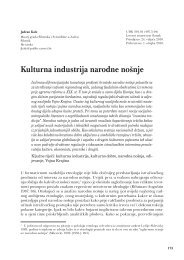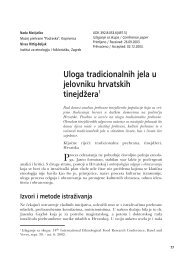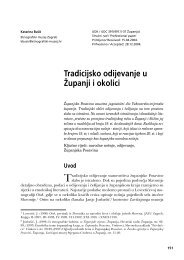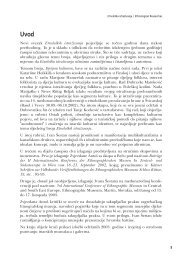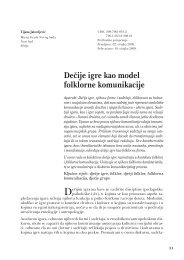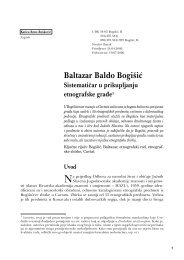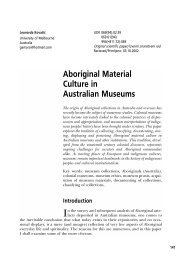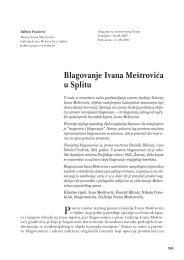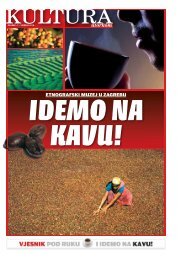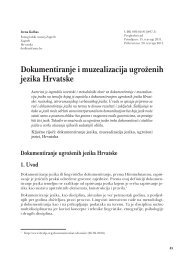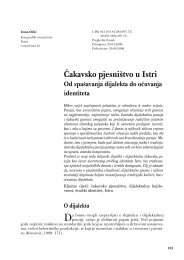Etnoloska istrazivanja / Ethnological researches - EMZ
Etnoloska istrazivanja / Ethnological researches - EMZ
Etnoloska istrazivanja / Ethnological researches - EMZ
You also want an ePaper? Increase the reach of your titles
YUMPU automatically turns print PDFs into web optimized ePapers that Google loves.
Etnološka istraživanja 15/<strong>Ethnological</strong> Researches 15<br />
soldiers of the Military Border in uniforms making their pilgrimage to the church in<br />
Kloštar and, on the other side, St. Roko and St. Sebastian.<br />
The other painting with brighter colours presents the assumption of the Blessed Virgin<br />
Mary to the heavens and is connected with the legend about returning the painting<br />
from Bosnia. It became miraculous. The third picture, which also presents the<br />
assumption of the Blessed Virgin Mary to the heavens, is artistically more valuable<br />
than the previous one (APPENDIX 2). Art historians place this miraculous picture to<br />
the second half of the 18 th century, while in the archive documents of the Kobaš parish<br />
it dates back to thirties of the 19 th century: ‘’In the year 1832 the chapel placed on the<br />
mutual cemetery in Kloštar was plastered. The altar of the Blessed Virgin Mary had been unpainted<br />
for forty years. The altar painting was made by painter Antun Keller from Zagreb.<br />
The painting was blessed by subarchdeacon Antun Vukasović. In the procession the painting<br />
was moved from the parish church to its earlier prepared altar. While the painting was being<br />
painted the parish priest was feeding the painter for free.’’ (APPENDIX 3). (The memorial<br />
of the Kobaš parish, 1824-1960:8, the list of registered monuments in the Administration<br />
for the protection of cultural heritage, Art-conservation department in Osijek,<br />
reg. number 15 – Inventory of the Holy Mother chapel, Dukić 2002: 50-59).<br />
The legend about the miraculous painting, written by the Kobaš parish priest, tells<br />
how the Turks took it to Bosnia to the mountain Motajica, and it kept coming back<br />
to Kloštar several times. At the place where it was crossing the river (Sava) there was<br />
the bell ringing sound, and on the mountain there was the trail in the woods. The<br />
seond version of this story tells that the painting was brought by the Franciscan friars<br />
while they were running away from the monastery in Jajce (Dukić, 2002:54). We<br />
find the folk legend about the returning of the painting from the mountain Motajica<br />
more interesting. In the last section of this work we will say something about the legend<br />
of the returned painting again.<br />
Now let us go back to the first and by origin the oldest painting. We said that it was<br />
painted on both sides. On one side, St. Roch and St. Sebastian, the protectors from<br />
plague and leprosy (APPENDIX 4). On the other side the painting presents, apart<br />
from the Sacred Family and soldiers of the Military Border making their pilgrimage<br />
to the Kloštar church, some other details as well. The image of the Holy Family<br />
is placed in the upper half of the painting. The lower half of the painting is made<br />
of three parts.<br />
The part in the lower left angle of the painting presents the prayer of priests and soldiers<br />
of the Military Border dressed in red trousers and blue blouses with red braids<br />
round their collars and sleeves. Among the soldiers, one of them has a blue blouse<br />
bordered with fur, and trousers with golden motives embroidered. That is probably<br />
a Kobaš military commanding officer. Standing beside him is probably his wife in a<br />
blue blouse and white-yellow long dress. Beside her, there are other women dressed<br />
in white dresses and wearing white head scarves on their heads. They are cloaked in<br />
long red cloaks (APPENDIX 5).<br />
302



